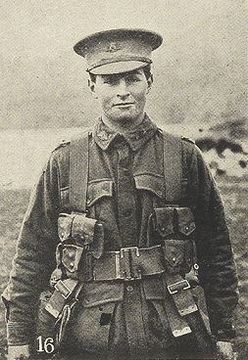RICHARDSON, Albert Henry
| Service Number: | 3495 |
|---|---|
| Enlisted: | 4 August 1915 |
| Last Rank: | Private |
| Last Unit: | 52nd Infantry Battalion |
| Born: | Launceston, Tasmania, Australia, 11 February 1896 |
| Home Town: | Launceston, Launceston, Tasmania |
| Schooling: | Not yet discovered |
| Occupation: | Labourer |
| Died: | Hobart, Tasmania, Australia, 8 August 1958, aged 62 years, cause of death not yet discovered |
| Cemetery: |
Cornelian Bay Cemetery and Crematorium, Tasmania |
| Memorials: |
World War 1 Service
| 4 Aug 1915: | Enlisted AIF WW1, Private, 3495, 12th Infantry Battalion | |
|---|---|---|
| 10 Nov 1915: | Involvement Private, 3495, 12th Infantry Battalion, --- :embarkation_roll: roll_number: '10' embarkation_place: Melbourne embarkation_ship: HMAT Ascanius embarkation_ship_number: A11 public_note: '' | |
| 10 Nov 1915: | Embarked Private, 3495, 12th Infantry Battalion, HMAT Ascanius, Melbourne | |
| 3 Mar 1916: | Involvement AIF WW1, Private, 3495, 52nd Infantry Battalion |
Help us honour Albert Henry Richardson's service by contributing information, stories, and images so that they can be preserved for future generations.
Add my storyBiography contributed by Stephen Brooks
Albert Henry Richardson of Launceston, Tasmania was part of a group of thirteen men of the 52nd Battalion who were all recommended for a bravery award, for the following deed. On 14 August 1916, “Some wounded men, having been left out in front of the firing line near the Farm de Mouquet, a party under Lieutenant Ralph Anderson volunteered to go out from Albert, a distance of 8 kilometres, and try and bring them in. This they did, having to make their way for a very long distance over ground and through saps that were being shelled heavily by the enemy; with much trouble in the darkness, they located the men in No Mans Land, near the enemy trenches, and brought them back to safety over ground that was being swept by our own guns and over the ground being bombarded by the enemy.”
There is no record of an award being made to Richardson in his service file, although the Launceston papers reported that he had been recommended for a D.C.M.
Albert suffered gas wounds during May 1918 but returned safely to Australia in mid-1919.









